Effect of Soil Moisture Content on the Shear Strength of Dicranopteris Linearis-Rooted Soil in Different Soil Layers of Collapsing Wall
Abstract
:1. Introduction
2. Materials and Methods
2.1. Study Area
2.2. Root Sample Collection and Pretreatment
2.3. Soil Collection and Basic Properties
2.4. Experimental Design
2.5. Remodeling Soil Preparation and Shear Test
2.6. The WWM
2.7. Statistical Analysis
3. Results
3.1. Relationship between SMC and Shear Strength of Collapsing Wall Rooted Soil
3.2. Relationship between SMC and Cohesion of Collapsing Wall Rooted Soil
3.3. Relationship between SMC and Internal Friction Angle of Collapsing Wall Rooted Soil
3.4. Relationship between SMC and Cohesion Increment Predicted by the Wu–Waldron Model
4. Discussion
4.1. Effect of SMC on the Shear Strength of the Rooted Soil in the Collapsing Wall
4.2. Effect of SMC on the Cohesion of the Rooted Soil in the Collapsing Wall
4.3. Effect of SMC on the Internal Friction Angle of the Rooted Soil in the Collapsing Wall
4.4. WWM Correction and Shear Strength Model Building
- (1)
- In the LL:τrs = (−13.61w2 + 4.07w + 0.53) × TR × RAR + Cs + σtan(−95.51w + 53.68)
R2 = 0.93, p < 0.01, NSE = 0.92 - (2)
- In the SL:τrs = (−6.63w2 + 1.71w + 0.14) × TR × RAR + Cs + σtan(−6.58lnw + 28.22)
R2 = 0.98, p < 0.01, NSE = 0.96 - (3)
- In the DL:τrs = (−6.65w2 + 2.84w − 0.22) × TR × RAR + Cs + σtan(−6.04lnw + 29.83)
R2 = 0.97, p < 0.01, NSE = 0.97
5. Conclusions
Author Contributions
Funding
Data Availability Statement
Conflicts of Interest
References
- Hao, W.; Xia, B.; Xu, M. Erosion-deposition positively reconstruct the bacterial community and negatively weaken the fungal community. Catena 2022, 217, 106471. [Google Scholar] [CrossRef]
- Zhang, R.; Rong, L.; Zhang, L. Soil nutrient variability mediates the effects of erosion on soil microbial communities: Results from a modified topsoil removal method in an agricultural field in Yunnan plateau, China. Environ. Sci. Pollut. Res. 2021, 29, 3659–3671. [Google Scholar] [CrossRef]
- van der Meij, W.; Reimann, T.; Vornehm, V.; Temme, A.; Wallinga, J.; van Beek, R.; Sommer, M. Reconstructing rates and patterns of colluvial soil redistribution in agrarian (hummocky) landscapes. Earth Surf. Process. Landf. 2019, 44, 2408–2422. [Google Scholar] [CrossRef]
- Liao, Y.; Yuan, Z.; Li, D.; Zheng, M.; Huang, B.; Xie, Z.; Wu, X.; Luo, X. What kind of gully can develop into benggang? Catena 2023, 225, 107024. [Google Scholar] [CrossRef]
- Wei, Y.; Liu, Z.; Wu, X.; Zhang, Y.; Cui, T.; Cai, C.; Guo, Z.; Wang, J.; Cheng, D. Can Benggang be regarded as gully erosion? Catena 2021, 207, 105648. [Google Scholar] [CrossRef]
- Liu, X.; Qiu, J.; Zhang, D. Characteristics of slope runoff and soil water content in benggang colluvium under simulated rainfall. J. Soils Sediments 2018, 18, 39–48. [Google Scholar] [CrossRef]
- Liao, Y.; Yuan, Z.; Zhuo, M.; Huang, B.; Nie, X.; Xie, Z.; Tang, C.; Li, D. Coupling effects of erosion and surface roughness on colluvial deposits under continuous rainfall. Soil Tillage Res. 2019, 191, 98–107. [Google Scholar] [CrossRef]
- Fullen, M.A. Effects of grass ley set-aside on runoff, erosion and organic matter levels in sandy soils in East Shropshire, UK. Soil Tillage Res. 1998, 46, 41–49. [Google Scholar] [CrossRef]
- Fattet, M.; Fu, Y.; Ghestem, M.; Ma, W.; Foulonneau, M.; Nespoulous, J.; Le Bissonnais, Y.; Stokes, A. Effects of vegetation type on soil resistance to erosion: Relationship between aggregate stability and shear strength. Catena 2011, 87, 60–69. [Google Scholar] [CrossRef]
- Pradhan, B.; Chaudhari, A.; Adinarayana, J.; Buchroithner, M.F. Soil erosion assessment and its correlation with landslide events using remote sensing data and GIS: A case study at Penang Island, Malaysia. Environ. Monit. Assess. 2012, 184, 715–727. [Google Scholar] [CrossRef]
- Li, R.; Kan, S.; Zhu, M.; Chen, J.; Ai, X.; Chen, Z.; Zhang, J.; Ai, Y. Effect of different vegetation restoration types on fundamental parameters, structural characteristics and the soil quality index of artificial soil. Soil Tillage Res. 2018, 184, 11–23. [Google Scholar] [CrossRef]
- Docker, B.B. Biotechnical Engineering on Alluvial Riverbanks of Southeastern Australia: A Quantified Model of the Earth-Reinforcing Properties of Some Native Riparian Trees. Ph.D. Thesis, University of Sydney, Camperdown, NSW, Australia, 2003. [Google Scholar]
- Bischetti, G.B.; Chiaradia, E.A.; Simonato, T.; Speziali, B.; Vitali, B.; Vullo, P.; Zocco, A. Root strength and root area ratio of forest species in Lombardy (Northern Italy). Plant Soil 2005, 278, 11–22. [Google Scholar] [CrossRef]
- Docker, B.; Hubble, T. Quantifying root-reinforcement of river bank soils by four Australian tree species. Geomorphology 2008, 100, 401–418. [Google Scholar] [CrossRef]
- Zhang, C.-B.; Chen, L.-H.; Liu, Y.-P.; Ji, X.-D.; Liu, X.-P. Triaxial compression test of soil–root composites to evaluate influence of roots on soil shear strength. Ecol. Eng. 2010, 36, 19–26. [Google Scholar] [CrossRef]
- Norris, J.E. Root reinforcement by hawthorn and oak roots on a highway cut-slope in southern england. Plant Soil 2005, 278, 43–53. [Google Scholar] [CrossRef]
- Fan, C.-C.; Su, C.-F. Role of roots in the shear strength of root-reinforced soils with high moisture content. Ecol. Eng. 2008, 33, 157–166. [Google Scholar] [CrossRef]
- Schwarz, M.; Phillips, C.; Marden, M.; McIvor, I.R.; Douglas, G.B.; Watson, A. Modelling of root reinforcement and erosion control by ‘Veronese’ poplar on pastoral hill country in New Zealand. N. Z. J. For. Sci. 2016, 46, 4. [Google Scholar] [CrossRef]
- Zhou, M.; Shuai, F.; Chen, L.; Huang, M.; Lin, J.; Zhang, Y.; Ge, H.; Jiang, F.; Huang, Y. Impact of Dicranopteris linearis roots on the shear strength of different soil layers in collapsing wall of Benggang. Eur. J. Soil Sci. 2022, 73, e13317. [Google Scholar] [CrossRef]
- Zhu, J.; Mao, Z.; Wang, Y.; Wang, Y.; Li, T.; Wang, K.; Langendoen, E.J.; Zheng, B. Soil moisture and hysteresis affect both magnitude and efficiency of root reinforcement. Catena 2022, 219, 106574. [Google Scholar] [CrossRef]
- Huang, M.; Sun, S.; Feng, K.; Lin, M.; Shuai, F.; Zhang, Y.; Lin, J.; Ge, H.; Jiang, F.; Huang, Y. Effects of Neyraudia reynaudiana roots on the soil shear strength of collapsing wall in Benggang, southeast China. Catena 2021, 210, 105883. [Google Scholar] [CrossRef]
- Shuai, F.; Huang, M.; Zhan, Y.; Zhu, Q.; Li, X.; Zhang, Y.; Lin, J.; Huang, Y.; Jiang, F. Effects of herbaceous plant roots on the soil shear strength of the collapsing walls of Benggang in southeast China. Forests 2022, 13, 1843. [Google Scholar] [CrossRef]
- Wang, C.; Li, Z.; Cai, B.; Tan, Q.; Li, Y.; He, L.; Tang, Q.; Huang, W.; Duan, X.; Deng, Y. Effect of root system of the Dicranopteris dichotoma on the soil unconfined compressive strength of collapsing walls in hilly granite area of South China. Catena 2022, 216, 106411. [Google Scholar] [CrossRef]
- Wu, T.H.; McKinnell, W.P., III; Swanston, D.N. Strength of tree roots and landslides on Prince of Wales Island, Alaska. Can. Geotech. J. 1979, 16, 19–33. [Google Scholar] [CrossRef]
- Ghestem, M.; Veylon, G.; Bernard, A.; Vanel, Q.; Stokes, A. Influence of plant root system morphology and architectural traits on soil shear resistance. Plant Soil 2014, 377, 43–61. [Google Scholar] [CrossRef]
- Duan, X.; Deng, Y.; Tao, Y.; He, Y.; Lin, L.; Chen, J. The soil configuration on granite residuals affects Benggang erosion by altering the soil water regime on the slope. Int. Soil Water Conserv. Res. 2021, 9, 419–432. [Google Scholar] [CrossRef]
- Liu, Y.-B.; Hu, X.-S.; Yu, D.-M.; Zhu, H.-L.; Li, G.-R. Influence of the roots of mixed-planting species on the shear strength of saline loess soil. J. Mt. Sci. 2021, 18, 806–818. [Google Scholar] [CrossRef]
- Horn, R. Stress–strain effects in structured unsaturated soils on coupled mechanical and hydraulic processes. Geoderma 2003, 116, 77–88. [Google Scholar] [CrossRef]
- Lian, B.; Peng, J.; Zhan, H.; Wang, X. Mechanical response of root-reinforced loess with various water contents. Soil Tillage Res. 2019, 193, 85–94. [Google Scholar] [CrossRef]
- Mohamed, T.A.; Ali, F.H.; Hashim, S.; Huat, B.B. Relationship Between Shear Strength and Soil Water Characteristic Curve of an Unsaturated Granitic Residual Soil. Am. J. Environ. Sci. 2006, 2, 142–145. [Google Scholar] [CrossRef]
- Lu, Y.; Lyu, M.; Xiong, X.; Deng, C.; Jiang, Y.; Zeng, M.; Xie, J. Understory ferns promote the restoration of soil microbial diversity and function in previously degraded lands. Sci. Total. Environ. 2023, 870, 161934. [Google Scholar] [CrossRef]
- Wu, T.H. Investigation of Landslides on Prince of Wales Island, Alaska; Geotechnical Engineering Report, 5; Ohio State University, Department of Civil Engineering: Columbus, OH, USA, 1976; p. 93. [Google Scholar]
- Waldron, L.J.; Dakessian, S. Soil reinforcement by roots: Calculation of increased soil shear resistance from root properties. Soil Sci. 1981, 132, 427–435. [Google Scholar] [CrossRef]
- Cohen, D.; Schwarz, M.; Or, D. An analytical fiber bundle model for pullout mechanics of root bundles. J. Geophys. Res. Earth Surf. 2011, 116, F03010. [Google Scholar] [CrossRef]
- Pollen, N.; Simon, A.; Collison, A.J.C. Advances in assessing the mechanical and hydrologic effects of riparian vegetation on streambank stability. In Riparian Vegetation and Fluvial Geomorphology; Bennett, S., Simon, A., Eds.; Water Science and Applications 8; AGU: Washington, DC, USA, 2004; pp. 125–139. [Google Scholar]
- Zhang, C.; Li, D.; Jiang, J.; Zhou, X.; Niu, X.; Wei, Y.; Ma, J. Evaluating the potential slope plants using new method for soil reinforcement program. Catena 2019, 180, 346–354. [Google Scholar] [CrossRef]
- Bischetti, G.B.; Chiaradia, E.A.; Epis, T.; Morlotti, E. Root cohesion of forest species in the Italian Alps. Plant Soil 2009, 324, 71–89. [Google Scholar] [CrossRef]
- Singh, H.V.; Thompson, A.M. Effect of antecedent soil moisture content on soil critical shear stress in agricultural watersheds. Geoderma 2016, 262, 165–173. [Google Scholar] [CrossRef]
- Olivella, S.; Alonso, E.E.; Pereira, J.M.; Vaunat, J. A microstructurally based effective stress for unsaturated soils. Geotechnique 2010, 60, 913–925. [Google Scholar] [CrossRef]
- Leung, K.A. Grass evapotranspiration-induced suction in slope: Case study. Environ. Geotech. 2014, 3, 155–165. [Google Scholar] [CrossRef]
- Zhu, J.Q.; Su, B.R.; Wang, Y.Q.; Wang, Y.J.; Li, Y.X. Variation of soil reinforcement of Vitex negundo root with roil moisture. Sci. Silvae Sin. 2020, 56, 202–208, (In Chinese with English abstract). [Google Scholar]
- Fu, J.T.; Yu, D.M.; Li, X.K.; Liu, C.Y.; Hu, X.S. Statistical probability analysis of the physical index of rooted soil in Qiadam basin. Chin. J. Rock Mech. Eng. 2020, 39, 1696–1709, (In Chinese with English abstract). [Google Scholar] [CrossRef]
- Zhang, D.-B.; Zhang, Y.; Cheng, T. Measurement of grass root reinforcement for copper slag mixed soil using improved shear test apparatus and calculating formula. Measurement 2018, 118, 14–22. [Google Scholar] [CrossRef]
- Waldron, L.J.; Dakessian, S.; Nemson, J.A. Shear resistance enhancement of 1.22meter diameter soil cross sections by pine and alfalfa roots. Soil Sci. Soc. Am. J. 1983, 47, 9–14. [Google Scholar] [CrossRef]
- Wei, J.; Shi, B.; Li, J.; Li, S.; He, X. Shear strength of purple soil bunds under different soil water contents and dry densities: A case study in the Three Gorges Reservoir Area, China. Catena 2018, 166, 124–133. [Google Scholar] [CrossRef]
- Hales, T.C.; Miniat, C.F. Soil moisture causes dynamic adjustments to root reinforcement that reduce slope stability. Earth Surf. Process. Landf. 2017, 42, 803–813. [Google Scholar] [CrossRef]
- Boldrin, D.; Leung, A.K.; Bengough, A.G. Effects of root dehydration on biomechanical properties of woody roots of Ulex europaeus. Plant Soil 2018, 431, 347–369. [Google Scholar] [CrossRef]
- Waldron, L.J. The shear resistance of root-permeated homogeneous and stratified soil. Soil Sci. Soc. Am. J. 1977, 41, 843–849. [Google Scholar] [CrossRef]
- Li, J.Y.; Yu, D.M.; Zhang, X.Y.; Hu, X.S.; Liu, Y.B.; Zhou, L.H.; Li, D. The effect of soil moisture content on the shear strength of rooted soil in loess regions of Xining Basin. J. Eng. Geol. 2022, 2, 281–292, (In Chinese with English abstract). [Google Scholar] [CrossRef]
- Saravanan, R.; Poongodi, K.; Murthi, P.; Sudharshan, E.; Gobinath, R. Effect of particle grain size on its shear strength behaviour of soils. IOP Conf. Ser. Mater. Sci. Eng. 2020, 981, 032079. [Google Scholar] [CrossRef]
- Zhang, X.M.; Ding, S.W.; Cai, C.F. Effects of drying and wetting on nonlinear decay of soil shear strength in slope disintegration erosion area. Trans. Chin. Soc. Agric. Eng. 2012, 28, 241–245, (In Chinese with English abstract). [Google Scholar] [CrossRef]
- Qi, Z.X.; Yu, D.M.; Liu, Y.B.; Fu, J.T.; Hu, X.S.; Li, S.X.; Zhao, D. Experimental research of factors affecting shear strength of halophyte root-soil composite systems in cold and arid environments. J. Eng. Geol. 2017, 25, 1438–1448, (In Chinese with English abstract). [Google Scholar] [CrossRef]
- Veylon, G.; Ghestem, M.; Stokes, A.; Bernard, A. Quantification of mechanical and hydric components of soil reinforcement by plant roots. Can. Geotech. J. 2015, 52, 1839–1849. [Google Scholar] [CrossRef]
- Zhong, R.-H.; He, X.-B.; Bao, Y.-H.; Tang, Q.; Gao, J.-Z.; Yan, D.-D.; Wang, M.-F.; Li, Y. Estimation of soil reinforcement by the roots of four post-dam prevailing grass species in the riparian zone of Three Gorges Reservoir, China. J. Mt. Sci. 2016, 13, 508–521. [Google Scholar] [CrossRef]
- Wu, Q.-S.; Cao, M.-Q.; Zou, Y.-N.; He, X.-H. Direct and indirect effects of glomalin, mycorrhizal hyphae and roots on aggregate stability in rhizosphere of trifoliate orange. Sci. Rep. 2014, 4, 5823. [Google Scholar] [CrossRef] [PubMed]
- Moreno-Espíndola, I.P.; Rivera-Becerril, F.; Ferrara-Guerrero, M.D.J.; De León-González, F. Role of root-hairs and hyphae in adhesion of sand particles. Soil Biol. Biochem. 2007, 39, 2520–2526. [Google Scholar] [CrossRef]

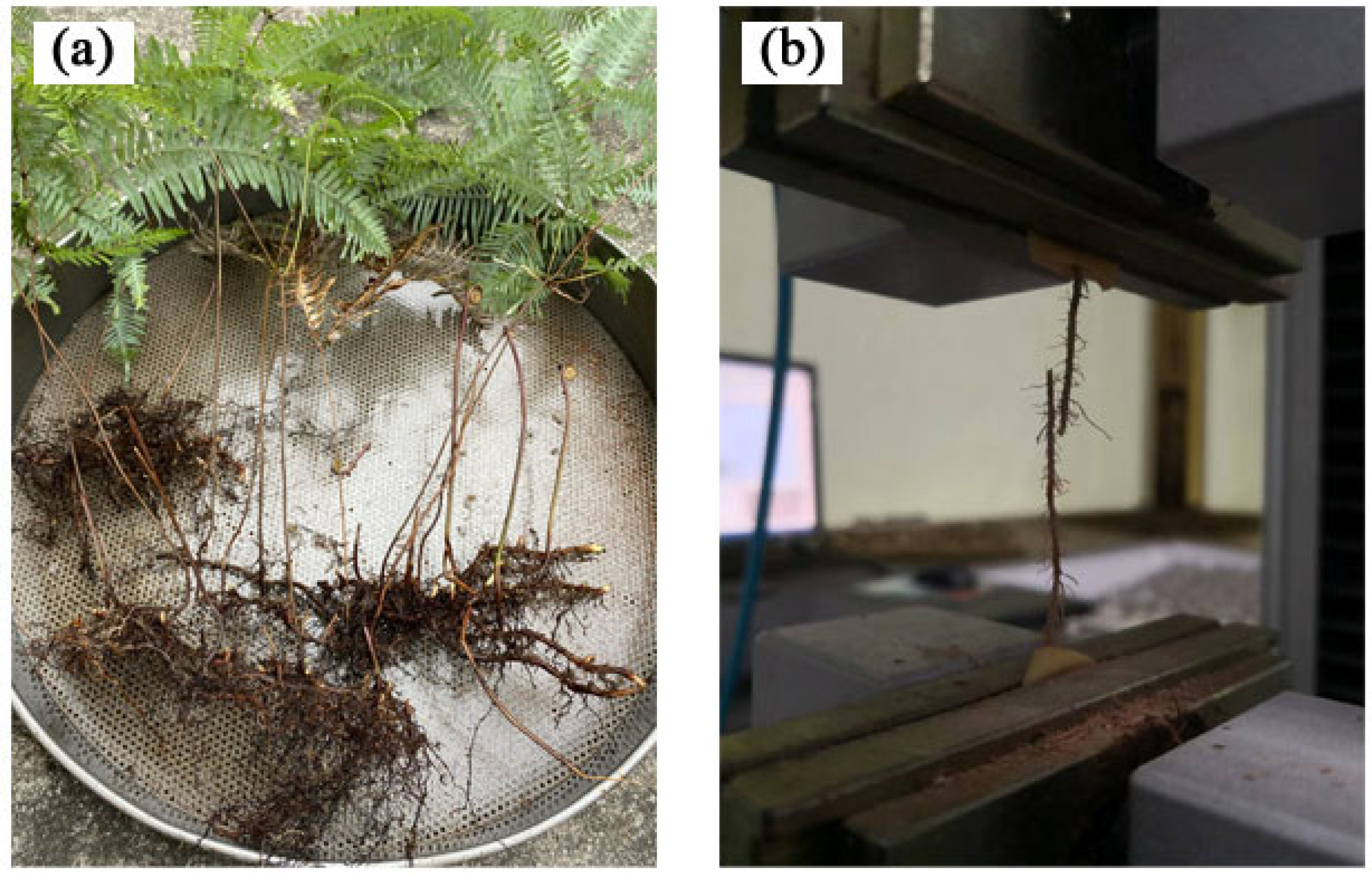

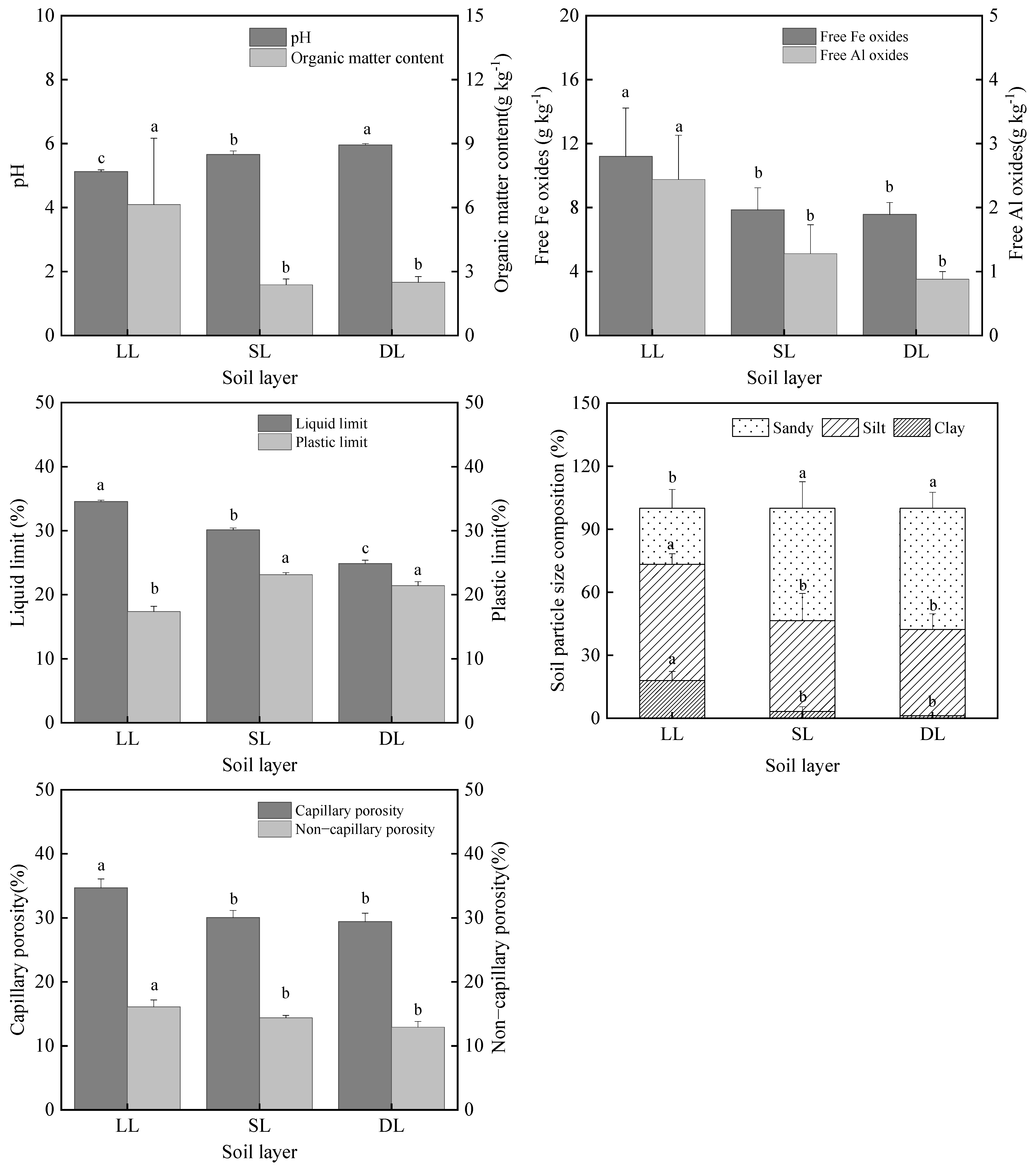

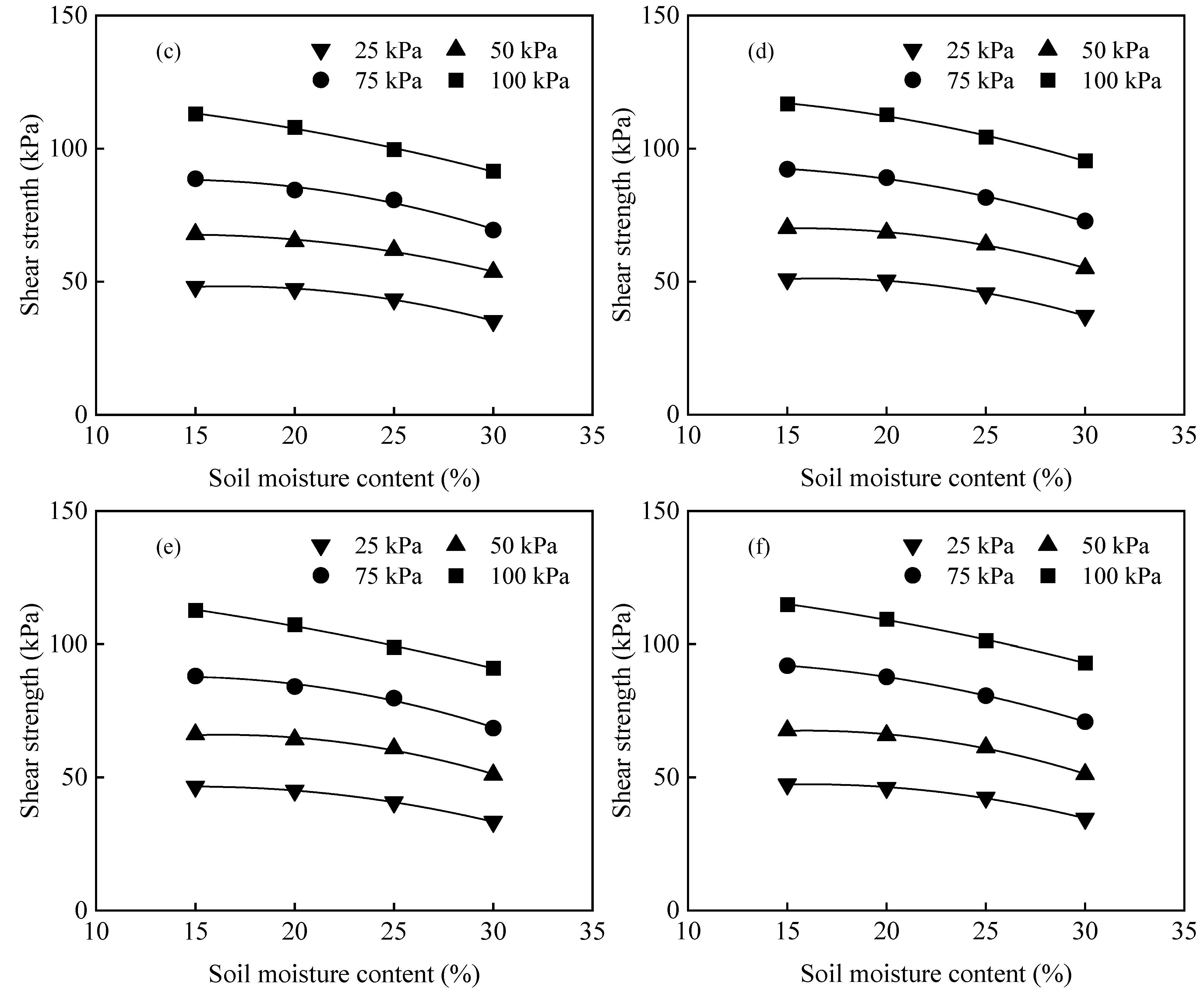

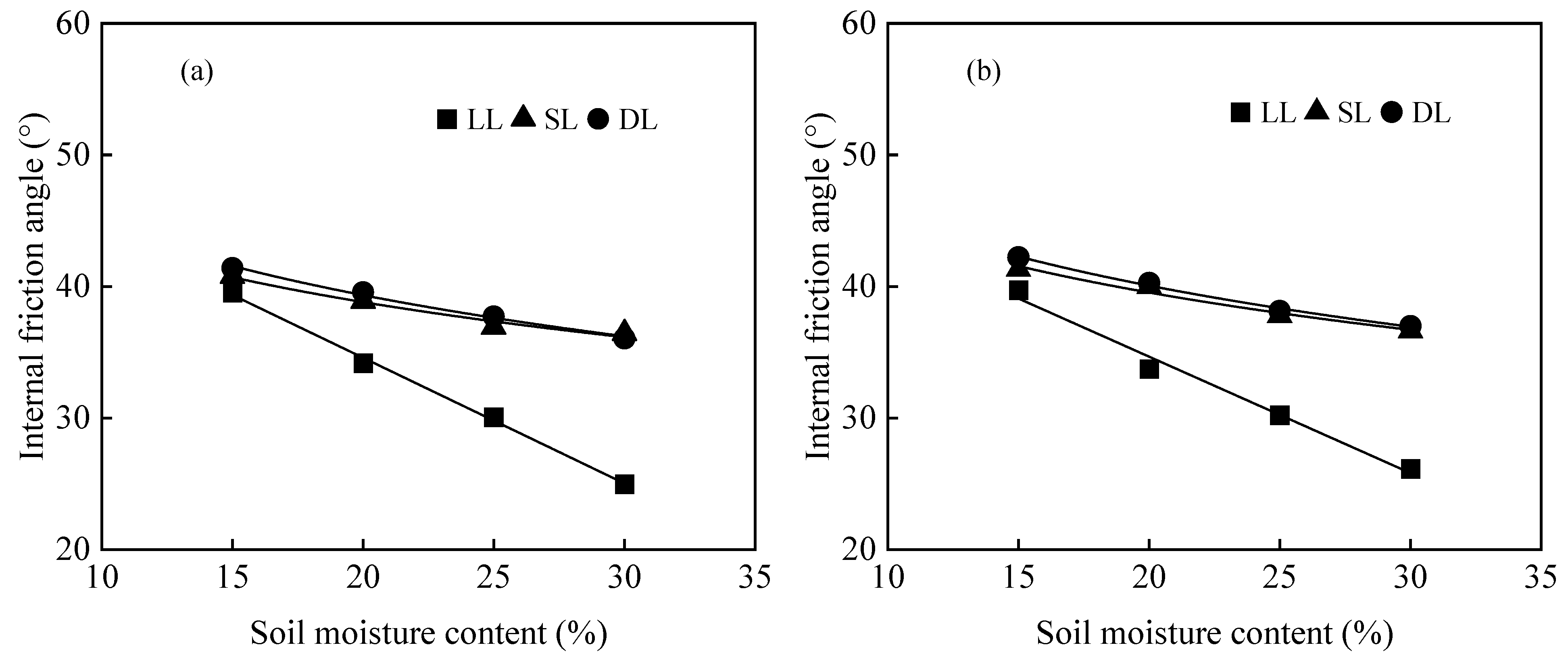

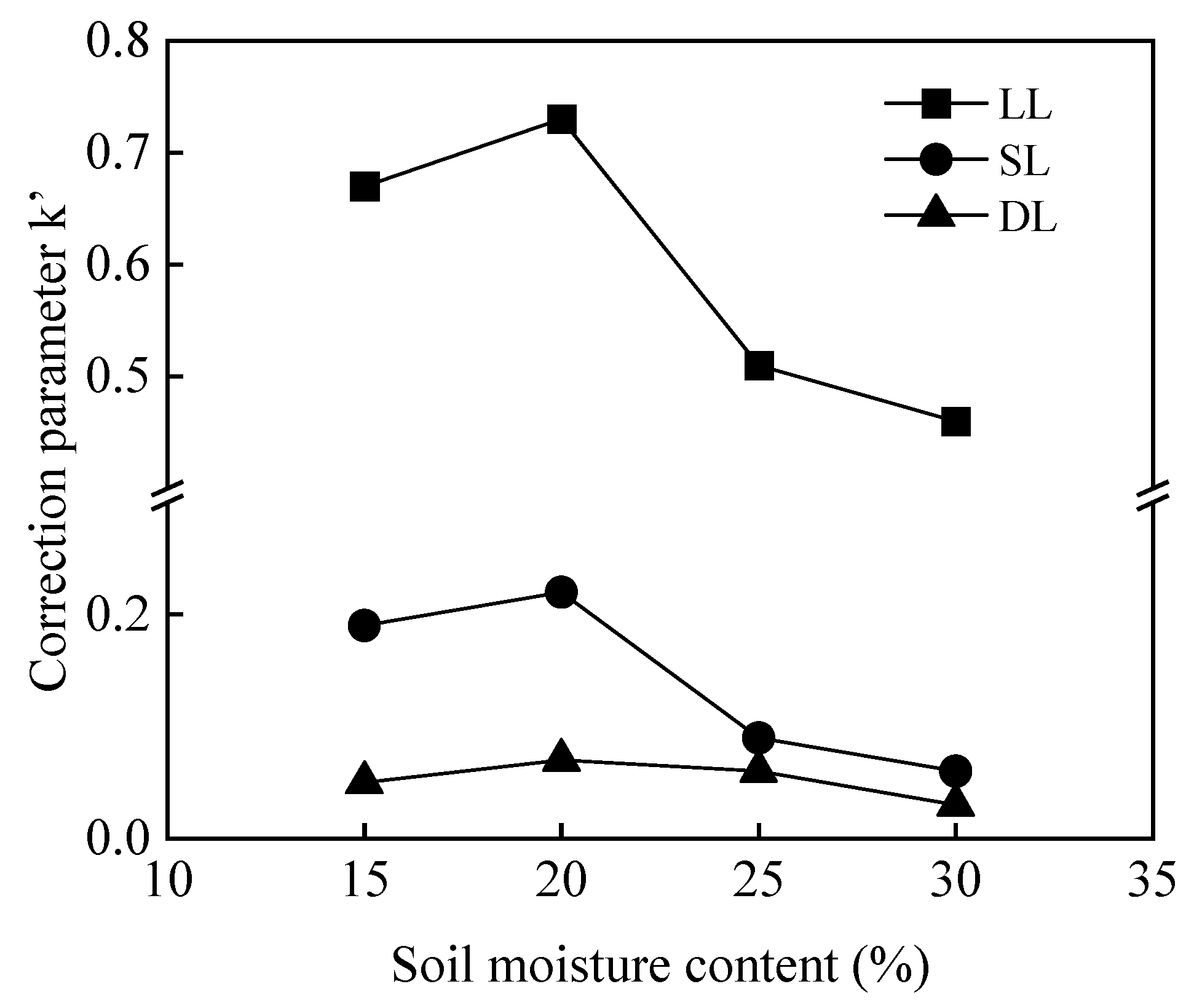
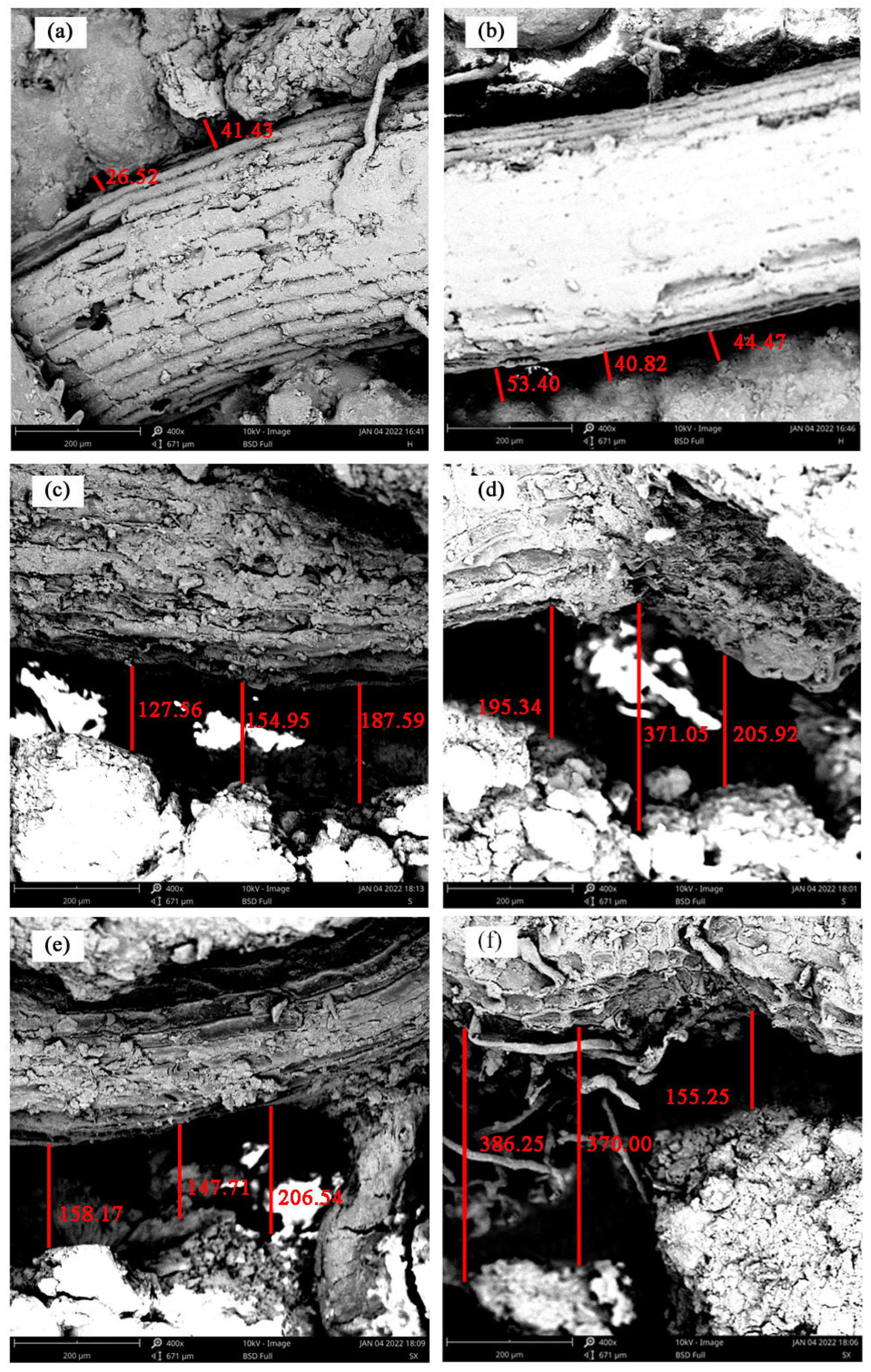

| Soil Layer | Rooted Soil | Plain Soil | ||||
|---|---|---|---|---|---|---|
| Root Content /g 100 cm−3 | Bulk Density /g cm−3 | SMC /% | Root Content /g 100 cm−3 | Bulk Density /g cm−3 | SMC /% | |
| LL | 0.75 | 1.35 | 15, 20, 25, 30 | 0.00 | 1.35 | 15, 20, 25, 30 |
| SL | 0.75 | 1.35 | 15, 20, 25, 30 | 0.00 | 1.35 | 15, 20, 25, 30 |
| DL | 0.75 | 1.35 | 15, 20, 25, 30 | 0.00 | 1.35 | 15, 20, 25, 30 |
| Soil Layer | Root Content /g 100 cm−3 | Fitting Equations | Optimal SMC/% | Optimal Cohesion/kPa | R2 | p | n |
|---|---|---|---|---|---|---|---|
| LL | 0.75 | C = −0.24 w2 + 10.92 w − 63.71 | 22.78 | 60.62 | 0.98 | <0.01 | 12 |
| SL | 0.75 | C = −0.12 w2 + 4.64 w − 16.47 | 19.67 | 29.14 | 0.97 | <0.01 | 12 |
| DL | 0.75 | C = −0.08 w2 + 2.96 w − 2.26 | 18.39 | 24.92 | 0.98 | <0.01 | 12 |
| Soil Layer | SMC/% | Cohesion Increment/kPa | Rates of Increment/% | Average Rates of Increment/% |
|---|---|---|---|---|
| LL | 15 | 7.14 | 18.52 | 13.72 |
| 20 | 7.75 | 14.88 | ||
| 25 | 5.46 | 10.29 | ||
| 30 | 4.87 | 11.18 | ||
| SL | 15 | 2.06 | 8.08 | 6.22 |
| 20 | 2.32 | 8.97 | ||
| 25 | 0.96 | 3.92 | ||
| 30 | 0.64 | 3.90 | ||
| DL | 15 | 0.50 | 2.16 | 2.66 |
| 20 | 0.75 | 3.15 | ||
| 25 | 0.65 | 3.00 | ||
| 30 | 0.31 | 2.28 |
| Soil Layer | Root Content /g 100 cm−3 | Fitting Equations | R2 | p | n |
|---|---|---|---|---|---|
| LL | 0.75 | φ = −0.89w + 52.36 | 0.99 | <0.01 | 12 |
| SL | 0.75 | φ = −0.33w + 46.27 | 0.99 | <0.01 | 12 |
| DL | 0.75 | φ = −0.36w + 47.42 | 0.99 | <0.01 | 12 |
| Soil Layer | SMC/% | Internal Friction Angle Increment/° | Rates of Increment /% | Average Rates of Increment/% |
|---|---|---|---|---|
| LL | 15 | 0.18 | 0.46 | 1.07 |
| 20 | −0.44 | −1.28 | ||
| 25 | 0.14 | 0.48 | ||
| 30 | 1.16 | 4.64 | ||
| SL | 15 | 0.54 | 1.33 | 2.50 |
| 20 | 1.14 | 2.92 | ||
| 25 | 0.89 | 2.41 | ||
| 30 | 1.19 | 3.35 | ||
| DL | 15 | −0.81 | −1.93 | −1.83 |
| 20 | −0.71 | −1.75 | ||
| 25 | −0.42 | −1.10 | ||
| 30 | −0.94 | −2.55 |
Disclaimer/Publisher’s Note: The statements, opinions and data contained in all publications are solely those of the individual author(s) and contributor(s) and not of MDPI and/or the editor(s). MDPI and/or the editor(s) disclaim responsibility for any injury to people or property resulting from any ideas, methods, instructions or products referred to in the content. |
© 2024 by the authors. Licensee MDPI, Basel, Switzerland. This article is an open access article distributed under the terms and conditions of the Creative Commons Attribution (CC BY) license (https://creativecommons.org/licenses/by/4.0/).
Share and Cite
Zhou, M.; Zhu, Q.; Wang, H.; Wang, X.; Zhan, Y.; Lin, J.; Zhang, Y.; Huang, Y.; Jiang, F. Effect of Soil Moisture Content on the Shear Strength of Dicranopteris Linearis-Rooted Soil in Different Soil Layers of Collapsing Wall. Forests 2024, 15, 460. https://doi.org/10.3390/f15030460
Zhou M, Zhu Q, Wang H, Wang X, Zhan Y, Lin J, Zhang Y, Huang Y, Jiang F. Effect of Soil Moisture Content on the Shear Strength of Dicranopteris Linearis-Rooted Soil in Different Soil Layers of Collapsing Wall. Forests. 2024; 15(3):460. https://doi.org/10.3390/f15030460
Chicago/Turabian StyleZhou, Man, Qin Zhu, He Wang, Xiaopeng Wang, Yuanyuan Zhan, Jinshi Lin, Yue Zhang, Yanhe Huang, and Fangshi Jiang. 2024. "Effect of Soil Moisture Content on the Shear Strength of Dicranopteris Linearis-Rooted Soil in Different Soil Layers of Collapsing Wall" Forests 15, no. 3: 460. https://doi.org/10.3390/f15030460






